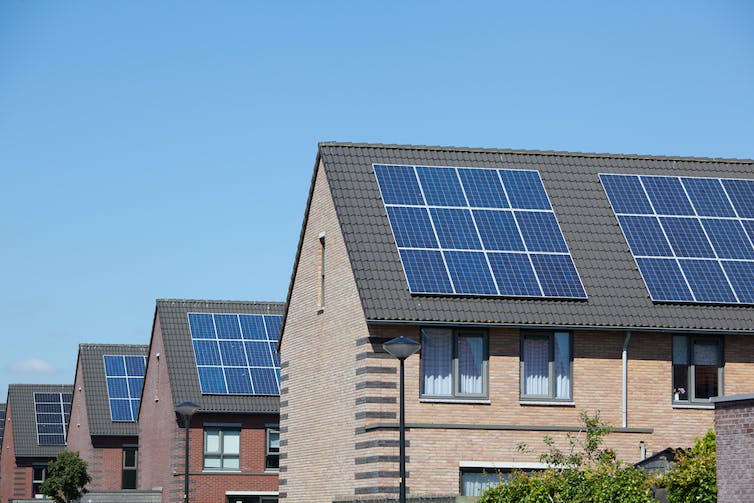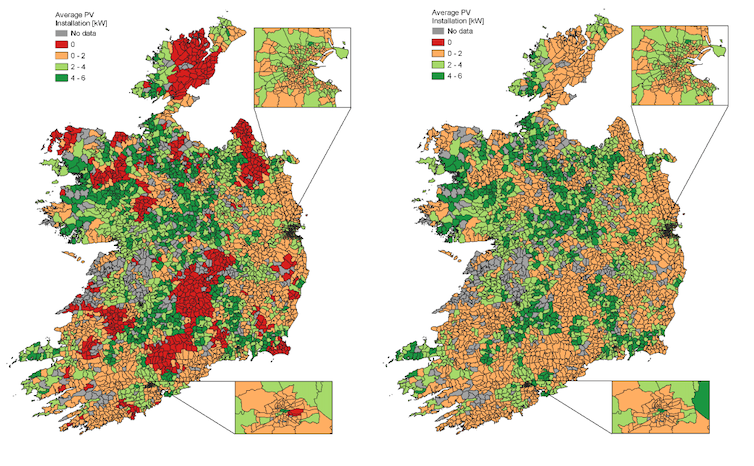Wozzie / shutterstock
Many folks are actually turning into “power residents” by putting in rooftop photo voltaic panels and different small-scale renewable power initiatives of their properties.
In concept, this can be a “win-win”. Added renewable power brings down the price of power, and by changing fossil fuels, cuts planet-warming carbon dioxide emissions. But there’s concern that as extra folks set up photo voltaic panels and different renewable initiatives, native electrical energy grids could turn out to be congested.
We wished to grasp this downside and suggest an answer, and our newest analysis has simply been printed. Though we targeted on Ireland, the place we dwell and work, one thing comparable is occurring throughout a lot of the world.
We first surveyed the nation’s total electrical energy infrastructure and found that if everybody wished rooftop photo voltaic, then the grid may solely serve 5% of the 1.6 million electrical energy clients studied.
That’s based mostly on every family wanting to put in 6 kilowatts of renewables – rooftop photo voltaic on one aspect of a typical home, for example, or a single small wind turbine – which is the utmost restrict supported by the microgeneration help scheme in Ireland. In different phrases, if everybody put in photo voltaic panels, then 95% of households wouldn’t be capable to join them to the nationwide grid.
This seems to reflect the scenario at current in electrical energy grids like that of California, Spain and Germany, the place early-comers are blocking entry for latecomers. While these nations are additional forward of their rollout of rooftop photo voltaic, parts of the electrical energy grid now don’t have any availability for brand new installations.
This is unfair: usually, more comfortable households are the primary to put in photo voltaic PV, and profit from subsidies. It additionally limits how helpful microgeneration might be to the general objective of decarbonising society.
A sport of musical chairs
The scenario may very well be in comparison with a sport of musical chairs.
The first downside is the variety of chairs: the electrical energy grid was not designed for each home to provide numerous renewable power. As the solar shines, for instance, each buyer with a photo voltaic panel should immediately use the electrical energy or spill it to the grid.
This is ok if just a few clients are spilling, however at a nationwide scale all that spilled power can exceed the bodily capability of the cables, inflicting equipment-damaging overvoltage or service interruptions from safety tripping. To forestall this the grid operator should restrict the quantity of renewable power related.

If each home seemed like this the nationwide grid couldn’t cope.
esbobeldijk / shutterstock
There are some methods to deal with this downside technically – to make extra chairs out there. These embody investing in new cables, or putting in dwelling battery banks and timed electrical car chargers in order that power use might be higher coordinated. But these concepts all include giant monetary prices.
Electricity grids in rich nations – the Irish grid being a very good instance – have been underneath building for over a century and re-purposing them will probably be no small feat. Doing this can be much more troublesome in rising economies attributable to extra struggles to cowl the prices.
The second downside is the music, or who will get to sit down first. Current coverage permits a “first-come first-served” method to putting in renewables, which inevitably provides precedence to high-income parts of society to search out an empty chair to sit down in, and to profit financially.
Justice implications
As the electrical energy sector is remodeled by renewable power, there are new justice implications value exploring. Imagine constructing a home, or transferring to an space sooner or later, to search out out that each one grid availability has already been taken and it isn’t potential so that you can join any new photo voltaic panels. The direct advantages of proudly owning a clear power set up should not for you.
Our analysis means that it’s potential to regulate this coverage to make grid availability a shared useful resource. First, as an alternative of blanket limits – just like the subsidised 6 kilowatts in Ireland – we’ll want an in depth evaluation of the grid to work out how a lot renewable era per family is truthful, or the utmost every can have with out affecting others.
This calculation is important as a result of that “justifiable share” varies for patrons, as there are technical constraints derived from the person’s location within the grid (how close to are they to a substation, how many individuals does that substation serve, how is it then related to the broader grid, and so forth).
The second method to higher share the grid is to acknowledge that some households have the cash to put in greater than their justifiable share, and as an alternative assist everybody else to work collectively. For occasion much less or succesful households may pool their shares in new photo voltaic panels or wind generators in alternate for cheaper electrical energy derived from these very installations.

The authors simulated how a lot rooftop photo voltaic a mean family in Ireland would have in 30 years with present coverage (left) and if grid entry was thought-about a shared useful resource (proper).
Cuenca et al
Factor in fairness
We ought to recognise some progress. Irish and European establishments try to attain decarbonisation objectives, and renewable power installations are certainly accelerating. The transition to low-carbon power is now inevitable – the query just isn’t if, however how, the transition is carried out.
But renewable power shouldn’t exacerbate current inequalities. Policies for home wind and photo voltaic ought to consider issues about fairness, that means we may enable all electrical energy clients to profit financially from clear power, and never simply from having cleaner air to breathe.
Our new analysis opens a dialogue for regulators and authorities establishments. This just isn’t about music or chairs, however concerning the elementary query of equity and possession in a fast-evolving power sector in Ireland and past.

Don’t have time to examine local weather change as a lot as you’d like?
Get a weekly roundup in your inbox as an alternative. Every Wednesday, The Conversation’s surroundings editor writes Imagine, a brief electronic mail that goes a bit of deeper into only one local weather challenge. Join the 20,000+ readers who’ve subscribed to this point.
![]()
Juan Jose Cuenca Silva obtained funding from the Government of Ireland by means of the "CENTS" analysis venture.
Barry Hayes receives funding Science Foundation Ireland by way of MaREI, the SFI Research Centre for Energy, Climate and Marine.
Hannah Daly receives funding to help analysis from MaREI, the SFI Centre for Climate, Energy and the Marine, the Sustainable Energy Authority of Ireland, and the Environmental Protection Agency.
